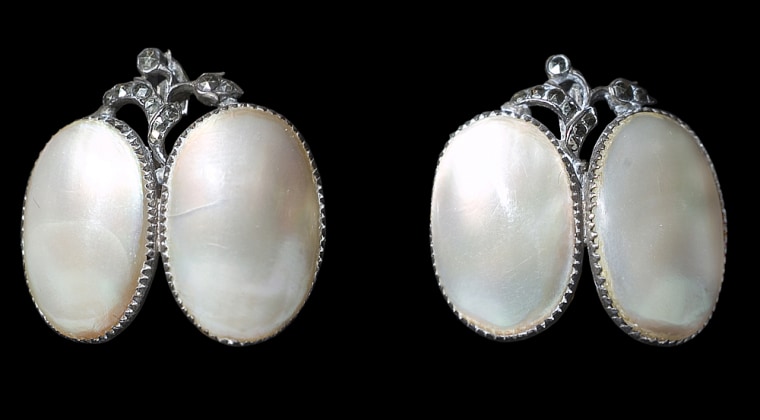A pair of mussel shell earrings set in silver and believed to be among the only surviving possessions of legendary American Indian princess Pocahontas went on display at a London museum Friday in their first public showing since 1907.
Each earring is formed of a double mussel-shell, the rare white kind found on the eastern shore of the Berings Strait. They are set in silver rims, inlaid with mother-of-pearl, and are worth approximately $500,000.
Pocahontas, daughter of Chief Powhatan of the Algonquin Nation, gained fame for keeping peace and serving as an "ambassador" between American Indians and British settlers.
Little is known with any certainty about her, but her life has been memorialized in stories, songs and images.
By legend, she saved Capt. John Smith from execution in 1607 before being captured by the English in 1612 and used as a pawn in dealing with her father. She converted to Christianity in 1613 and married tobacco planter John Rolfe a year later.
She sailed for London in 1616 to great fanfare in a trip aimed at obtaining funding for a Jamestown Christian school for American Indian children. She may have received the earrings during that trip. She died in 1617 and was buried at St. George's Church in Gravesend, near London.
The earrings were handed down through the Rolfe family and now belong to the Association for Preservation of Virginia Antiquities.
"She is often referred to as an ambassador between two cultures. You can see her coming (to London) and dying here and being buried here as evidence of that, as sort of a link between the two countries," said Bly Straube of the Virginia antiquities group.
Famous legend a misunderstanding?
Legend has it that Pocahontas' link to the colonists began when she flung herself over Smith to save him from execution by her father, who had made Smith place his neck on a rock.
But anthropologists examining Smith's papers believe he may have misunderstood what happened. Straube said the tribe only meant to initiate Smith as family through a ritual in which the tribe leader's daughters welcomed him.
"The Indian way of killing people was not to lay them against a rock and bash out their brains," Straube said. "They would tie them to a tree and use shells and scrape their skin off and dig out their entrails."
The earrings were sent from Virginia for the exhibition at the Museum of Docklands marking the upcoming 400th anniversary of the first permanent British settlement in America at Jamestown, Va., which was founded in 1607. They will be on display until July 10, when they will be moved back for the 2006 opening of a new museum of colonial artifacts.
The Jamestown collection from the early 17th century also includes tobacco pipes, freshwater pearls and a silver ear pick, a tool for cleaning earwax that was regarded as a symbol of high social class.
